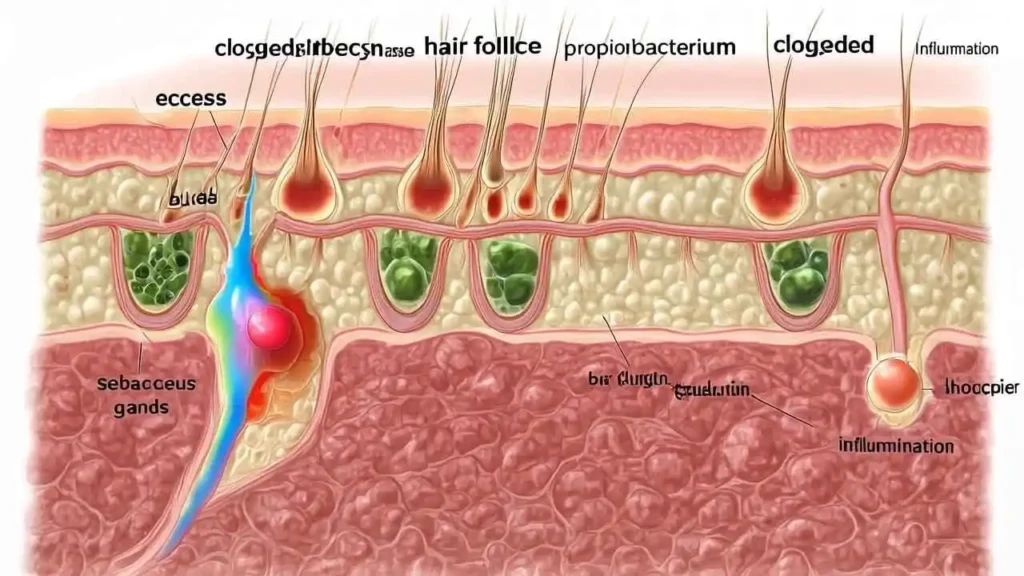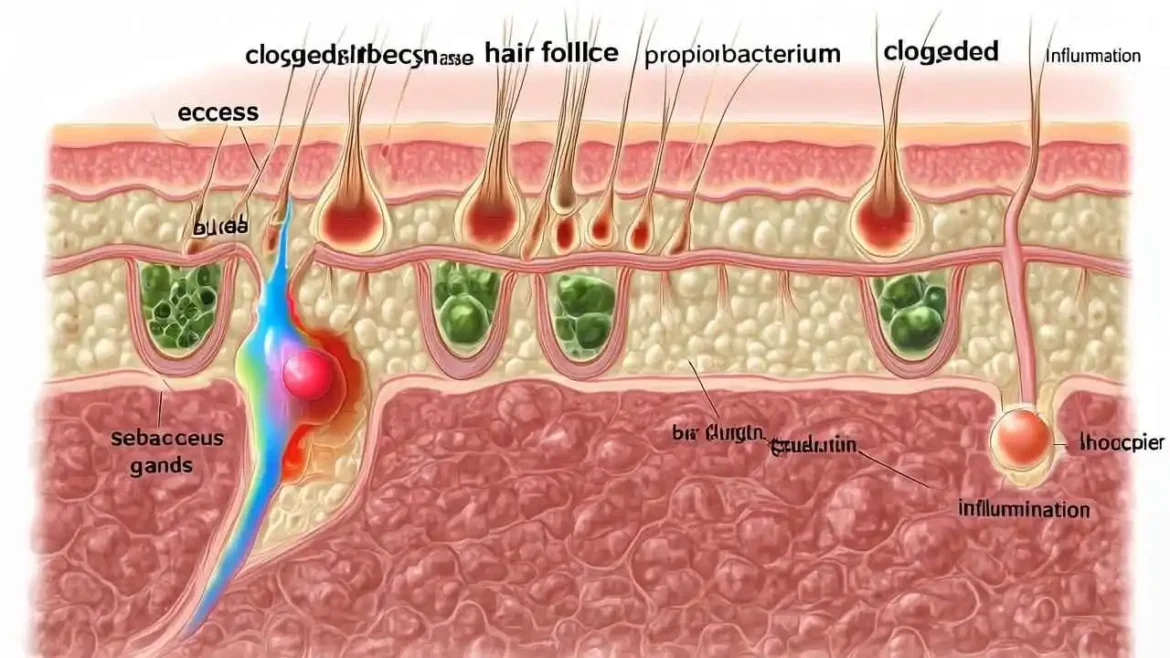
Acne Vulgaris: Understanding the Condition Beyond the Surface
As we navigate the complexities of health and wellness, few conditions are as common, yet as misunderstood, as acne vulgaris. Often dismissed as a mere teenage affliction or a sign of poor hygiene, the reality is far more intricate. For millions of us, acne is a chronic, inflammatory skin condition that can persist well into adulthood, impacting not only our skin’s health but also our self-esteem and quality of life. In this guide, we will delve into the science of acne vulgaris, exploring its causes, various forms, treatment hierarchies, and the essential role of a consistent skincare routine.
What is Happening Beneath the Skin? Unraveling the Science of Acne
While the visible manifestations of acne – the red bumps, whiteheads, and blackheads – appear on the surface, the true battle begins much deeper, within the microscopic architecture of our skin. At its core, acne vulgaris is a fundamental disorder of the pilosebaceous unit, a tiny but critical structure consisting of a hair follicle (a pore) and its attached sebaceous (oil) gland.
Imagine this unit as a miniature tube, designed to allow hair and sebum to exit smoothly. In acne, this system goes awry. The journey from a clear pore to a noticeable lesion is a cascading process, initiated deep within the pore and involving a complex interplay of four primary, interrelated factors:
1. Excess Sebum Production (Seborrhea)
Our sebaceous glands are vital for skin health, producing an oily, waxy substance called sebum. Sebum’s natural role is to lubricate the skin and hair, maintaining a healthy skin barrier and providing some natural protection. However, these glands are highly responsive to hormonal signals, particularly androgens (male hormones present in both sexes). During periods of hormonal fluctuation, such as puberty, menstruation, stress, or due to certain medical conditions, these glands can become hyperactive, leading to an overproduction of sebum – a condition known as seborrhea.
This excessive oil creates an unideal environment. Instead of a balanced lubrication, the pore becomes flooded with a thick, viscous substance. This not only makes the skin appear visibly oily but also lays the groundwork for the next critical step in acne development, acting as a rich nutrient source for certain bacteria.
2. Hyper keratinization (Abnormal Cell Shedding)
Under normal circumstances, the cells lining the hair follicle, called keratinocytes, regularly shed and are naturally expelled from the pore’s opening. This is a continuous, healthy renewal process. In hyper keratinization, however, this process becomes disrupted. Instead of shedding normally, these keratinocytes become sticky, adhering to each other and to the walls of the follicle.
They accumulate within the pore, stubbornly refusing to exit. This sticky clump of dead skin cells, combined with the excess sebum, forms a microscopic plug deep within the follicle, effectively blocking its opening. This initial, often invisible plug is known as a microcomedone. It’s the silent precursor to all acne lesions. As more cells and sebum accumulate, this plug expands, forming the basis for open comedones (blackheads) or closed comedones (whiteheads).
3. Bacterial Proliferation (C. acnes Overgrowth)
With the follicle now blocked and overflowing with sebum, a perfect storm for bacterial proliferation begins. The plug creates an anaerobic (oxygen-free) environment – precisely the conditions favored by a specific type of bacterium known as Cut bacterium acnes (C. acnes). C. acnes (formerly Propionibacterium acnes) is a normal, usually harmless resident of our skin’s microbiome.
However, in this oxygen-deprived, sebum-rich environment, C. acnes multiplies rapidly and uncontrollably. As it consumes the abundant sebum, it breaks down triglycerides into irritating free fatty acids. This overgrowth of bacteria, coupled with their metabolic byproducts, begins to irritate the sensitive lining of the follicle, signaling alarm to the body’s immune system.
4. Inflammation (The Immune Response)
The rapid proliferation of C. acnes and the presence of its irritating byproducts trigger a robust immune response within the body. Recognizing the bacterial overgrowth and the compromised follicle as a threat, the immune system dispatches a cascade of inflammatory cells (such as neutrophils and macrophages) to the site.
This immune attack is an attempt to fight off the bacteria and clear the debris within the blocked follicle. However, this protective response itself contributes to the visible symptoms of acne. The influx of inflammatory cells and the release of their chemical mediators cause the characteristic redness, swelling, heat, and pain associated with inflammatory acne lesions.
Depending on the severity of this inflammatory response and how deep it occurs within the skin, various lesions can form:
- Papules: Small, red, tender bumps lacking a pus head.
- Pustules: Red, tender bumps with a white or yellow center of pus.
- Nodules: Large, painful, solid lesions deeper in the skin.
- Cysts: Large, painful, pus-filled lesions that can cause significant scarring.
In essence, acne is not simply “dirty skin” or a superficial issue, but a complex biological cascade where hormones, cell behavior, bacteria, and the immune system all play a critical, interconnected role beneath the surface. Understanding these underlying processes is key to effective treatment.
Identifying the Types of Acne Lesions: A Guide to Understanding Your Skin
Not all blemishes are created equal, and mistaking one type for another can lead to ineffective treatments and prolonged frustration. Understanding the specific type of lesion you are dealing with is not just helpful, it’s crucial for selecting the most effective treatment strategy, preventing long-term scarring, and gaining a clearer picture of your skin’s health. Acne lesions, which are essentially manifestations of blocked and inflamed pores, are broadly categorized into two primary types: non-inflammatory and inflammatory. This distinction is fundamental to grasping the progression and severity of acne.
Let’s delve deeper into each category and the distinct characteristics of the lesions within them:
I. Non-Inflammatory Acne Lesions
These are generally the earliest forms of acne and typically do not involve redness, swelling, or pain unless irritated. They arise from the initial blockage of the hair follicle by a combination of excess sebum (oil) and dead skin cells.
- Whiteheads (Closed Comedones)
- Description: Whiteheads occur when a hair follicle becomes completely blocked beneath the skin’s surface. This blockage traps sebum, dead skin cells, and sometimes bacteria within the follicle, forming a small, flesh-colored or whitish bump that remains entirely closed over. Because the pore’s opening is sealed, the contents are not exposed to air, which is why they retain their pale appearance. They often present as tiny, raised bumps that can give the skin a bumpy or uneven texture.
- Appearance: Small, rounded, usually skin-colored or slightly whitish bumps without a visible pore opening.
- Feel: Smooth but noticeable to the touch, often appearing in clusters.
- Blackheads (Open Comedones)
- Description: In contrast to whiteheads, blackheads form when the follicle is only partially blocked, allowing the trapped sebum and dead skin cells to have an opening to the skin’s surface. When these contents are exposed to air, they undergo oxidation, which causes the melanin (pigment) in the dead skin cells and oxidized oil to darken. It’s a common misconception that blackheads are filled with dirt; rather, their dark appearance is a chemical reaction, not due to lack of hygiene.
- Appearance: Small, flat, or slightly raised dark spots (black or dark brown) with a visible, often widened, pore opening.
- Feel: Generally smooth to the touch, sometimes with a slightly rough texture if numerous.
II. Inflammatory Acne Lesions
These lesions represent a more advanced stage of acne, where the blocked follicle wall has ruptured, leading to an immune response and inflammation in the surrounding skin. They are typically characterized by redness, swelling, and often pain.
- Papules
- Description: Papules are small, red, tender bumps that result when the wall of a blocked follicle ruptures, spilling its contents (sebum, dead skin cells, bacteria) into the surrounding skin tissue. This triggers an inflammatory response in the body, leading to redness and swelling. Crucially, papules have no visible pus head; they are solid and firm to the touch. They represent the first true sign of inflammatory acne.
- Appearance: Small (<5mm), solid, raised, red bumps.
- Feel: Tender or painful to the touch.
- Pustules
- Description: Commonly what people refer to as a “pimple,” a pustule is essentially an inflamed papule that has progressed to develop a visible center filled with pus. This pus is a collection of dead white blood cells, bacteria, and tissue fluid, indicating the body’s active fight against the infection. Pustules are typically more superficial than nodules or cysts, making the pus head visible as a white or yellowish center surrounded by a red, inflamed base.
- Appearance: A red, inflamed bump with a distinct white or yellowish center (the pus head).
- Feel: Tender, soft at the center, and can be painful.
- Nodules
- Description: Nodules represent a more severe form of inflammatory acne. They occur when intense inflammation and infection develop deep within the skin, much deeper than a typical papule or pustule. The follicle wall ruptures, releasing contents into the dermis (a deeper layer of skin), leading to a significant and painful immune response. Nodules are large, solid, and firm to the touch, lacking a visible pus head on the surface. Because of their depth and the extensive tissue damage they cause, nodules carry a high risk of scarring.
- Appearance: Large (often >5mm), solid, red, painful lumps that are embedded deep beneath the skin’s surface.
- Feel: Hard, firm, and often very painful to the touch.
- Cysts
- Description: Cysts are the most severe form of acne lesions and are often associated with cystic acne. Similar to nodules, they form deep within the skin, but unlike nodules, cysts are truly pus-filled and often feel softer or more fluid-filled than the hard consistency of a nodule. These large, painful, pus-filled lumps can erupt into the surrounding tissue, creating interconnected tracts beneath the skin’s surface. Due to the extensive inflammation and destruction of skin tissue, acne cysts carry the highest risk of severe and disfiguring scarring, including icepick, boxcar, and rolling scars.
- Appearance: Large, deep, pus-filled, red, and inflamed lumps, often with a soft, fluctuating feel.
- Feel: Soft, spongy, or fluid-filled; often extremely painful.
Understanding these distinct types of acne lesions is the first step towards effective management. While non-inflammatory lesions might respond to over-the-counter topical treatments, inflammatory lesions, especially nodules and cysts, often require medical intervention from a dermatologist to prevent progression, reduce pain, and minimize the risk of permanent scarring. Recognizing the specific blemishes on your skin empowers you to make informed decisions about your skincare and seek professional help when necessary.
| Category | Lesion Type | Description |
| Non-Inflammatory | Whiteheads (Closed Comedones) | The follicle is completely blocked, trapping sebum and dead skin cells under the skin’s surface, appearing as a small, white bump. |
| Blackheads (Open Comedones) | The follicle is partially blocked, allowing the trapped sebum and skin cells to be exposed to air. The plug oxidizes and turns dark. | |
| Inflammatory | Papules | Small, red, tender bumps that have no visible pus. This is when the follicle wall has ruptured due to inflammation. |
| Pustules | Often called a “pimple,” this is a papule with a visible white or yellow center filled with pus (a collection of dead white blood cells). | |
| Nodules | Large, solid, painful lumps that form deep beneath the skin’s surface. They are a severe form of acne and can lead to scarring. | |
| Cysts | Deep, painful, pus-filled lumps that are softer than nodules. Cysts represent the most severe form of acne and carry a high risk of scarring. |
Common Triggers and Contributing Factors in Acne Vulgaris





